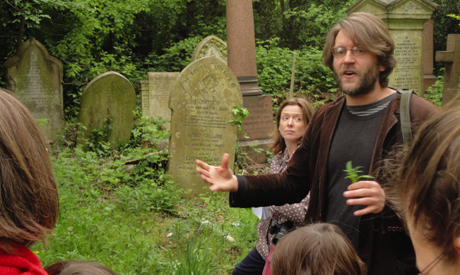Guides lead foragers into Abney Park Cemetery

Nick Saltmarsh waxes lyrical about edible flora on a foraging tour. Photograph: Kalyeena Makortoff
Foraging enthusiasts are traversing Hackney’s parks as part of courses aimed at educating residents about what wild food grows on their doorsteps.
But experts are urging new pickers to get acquainted with plant identification, heed local laws and be wary of environmental pollutants before putting Hackney greens on their dinner plate.
Foraging walks are run by groups including Forage London, Suffolk-based Food Safari and Forage
Wild Food.
They take advantage of plant diversity in Clissold, Springfield, and Victoria Parks, Hackney Downs, and Hackney Marshes.
“It’s shocking how much variety there is, even from one park to another,” says Forage London guide and founder John Rensten.
“You could spend a lifetime becoming an expert on foraging in Hackney and you would still have plenty left to learn.”
A walk through Stoke Newington’s Abney Park Cemetery with Food Safari doesn’t disappoint.
Wild garlic, sloes, nettles, raspberries, cow parsley and rosebay willow herb are identified along the footpaths by local guide Nick Saltmarsh – and that’s only the spring foliage.
But this is not a tour that ends in a feast. Trace levels of lead, arsenic and mercury from the cemetery’s graves can be found in the greenery and definitely rule out a salad.
Both Rensten and Saltmarsh agree that any plant which easily absorbs environmental pollutants, like mushrooms, should not be eaten in the city. Foragers should be aware of any historical industrial activity in the area they are picking from.
Saltmarsh also cautions against road-side greens and low-growing plants where dog waste could be found, saying it is important to be aware of dog walking routes.
Abney Park’s status as a nature reserve limits Food Safari to running strictly education tours there. Picking is strictly illegal in Abney Park, but the laws for the rest of the borough’s parks are not as clearcut and Hackney Council has no written policy on foraging.
Though a parks by-law forbidding people from removing, uprooting or plucking foliage has been used by the City of London to restrict foraging in Hampstead Heath and Epping Forest, Hackney Council’s efforts in this area have been relatively lax.
The council is planning to review the by-laws later this year following an as yet unscheduled consultation.
The laws have not changed at all since being adopted from the Greater London Council in 1971.
As it stands, the council generally discourages anything that damages plants or habitats for animals and wants to remind people that parks are public places to be enjoyed by everyone. Take the train or cycle out of the city, however, and there are a great variety of habitats where wild ingredients can be obtained. Forage London successfully received permission to hold foraging walks in Clissold, Springfield and Victoria Park earlier this year.
“If you talk about wild food in the park, people think you are going to be taking branches off trees or ripping up roots,” says Rensten. “I walk through Clissold Park and I come to a common lime tree, I pick three leaves and walk on. At most, I might pick a small salad.
“I don’t advocate anyone turning anything in the park into a staple.”
Saltmarsh cautions against the idea that foraging can form part of a lifestyle choice.
“Don’t come to foraging from a survivalist point of view,” he adds. “Sometimes foraging is just about a taste and having that extra sensory experience rather than gathering enough for a meal.
“But that can be really worthwhile, an extra element to enjoy.”
Foraging tours and courses run by various groups range in price from £15 to £40.
